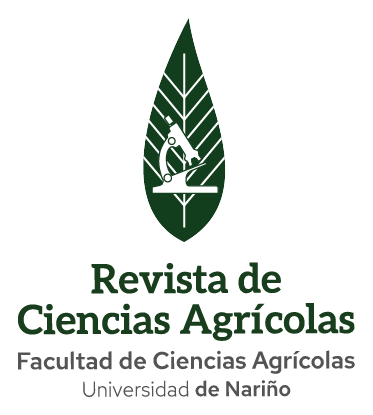DISTRIBUCIÓN DE LAS RAICES DEL CHONTADURO (Bactris gasipaes K.) EN MONOCULTIVO PARA FRUTO, PALMITO Y EN ASOCIO CON OTROS CULTIVOS.
Abstract
En la Estación Experimental El Mira, Corpoica, Tumaco y en fincas particulares cercanas a ésta, se estudió la distribución del sistema radical del chontaduro en monocultivo y en asocio con otras especies. Los datos de campo se analizaron con un modelo estadístico completamente al azar con anidamiento y una prueba de Duncan; las raíces de una palma fueron la unidad experimental. Además se correlacionaron la altura y el diámetro del tallo con el número y el peso de las raíces. Se encontró que el 83% de las raíces se localizan en los primeros 30 cm del perfil del suelo; que el 45% forman una densa red de un metro de radio, el 26% miden hasta dos metros, mientras que el 29% miden entre dos y más de tres metros de longitud. Se conoció que cada palma produce en promedio 66.4 kg de materia seca radical y que en asocio con cacao produce 173.1 kg. Los sistemas monocultivo palmito produjeron mayor cantidad de raíces por hectárea y la mejor tasa de renovación de su sistema radical, debido a las altas densidades de siembra; el sistema Palmito III produjo 157.7 ton/ha de materia seca radical. Se encontró que para obtener un rápido crecimiento del tallo para palmito, en diámetro y altura, las palmas de chontaduro deben poseer un sistema radical extenso, pesado y compuesto por numerosas raíces.
ABSTRACT
The distribution of the root system of peach palm in monoculture and associated with other species was studied in the Experimental Station El Mira of Corpoica at Tumaco and in private farms near to it. Field data were analyzed under a complete random design with nested distribution and tested using Duncan; being the roots of a palm the experimental unit. Height and the diameter of the plant were correlated with the number and weight of roots. It was found that 83% of roots are located in the first 30 cm of soil profile; 45% form a dense net of one meter of radio; 26% reach up to 2 meters, and 29% measure between two and more than three meters of length. It was observed that each palm produced 66.4 kg of radical they matter and in association with cocoa produced 173.1 kg. Monoculture systems for production of heart palm showed a greater quantity of roots per hectare and a best rate of radical system renovation due to the higher plantation density. The system Heart palm III produced 157.7 ton/ha of radical dry matter; it was also observed that to get a quick growth of the trunk for heart palm, in diameter and height, the palm most have and extensive, heavy radical system, composed by numerous roots.




























